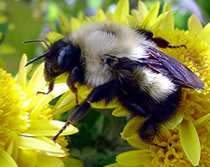 In an effort to stem a massive bee die-off, government scientists have developed honey bees with a genetic ability to fight back aggressively against Varroa mites which have decimated bee hives since 2004, killing one million colonies in North America in 2007 alone.
In an effort to stem a massive bee die-off, government scientists have developed honey bees with a genetic ability to fight back aggressively against Varroa mites which have decimated bee hives since 2004, killing one million colonies in North America in 2007 alone.
U.S. Department of Agriculture researchers have uncovered the genetic trait that allows honey bees to more easily find the parasitic mites and literally toss them out of the hive. Normally, the colony would eventually be killed off if the mite infestation were left alone.
Varroa-sensitive hygiene (VSH) is the genetic trait (a kind of mite radar) that allows bees to root out any mite-infested pupae. Honey bees are naturally hygienic, and they often remove diseased brood from their nests. VSH is a specific form of nest cleaning focused on removing varroa-infested pupae. The VSH honey bees are quite aggressive in their pursuit of the mites. The bees gang up, chew and cut through the wax cap, lift out the infected brood and their mites, and discard them from the broodnest.
This hygiene kills the frail mite offspring, which greatly reduces the lifetime reproductive output of the mother mite. The mother mite may survive the ordeal and try to reproduce in brood again, only to undergo similar treatment by the bees.
The Agricultural Research Service scientists at the Honey Bee Breeding, Genetics and Physiology Research Unit, in Baton Rouge, La., have developed honey bees with high expression of the VSH trait. Simpler ways for bee breeders to measure VSH behavior in colonies were also developed in this study.
To test the varroa resistance of VSH bees, the Baton Rouge team conducted field trials using 40 colonies with varying levels of VSH. Mite population growth was significantly lower in VSH and hybrid colonies than in bee colonies without VSH. Hybrid colonies had half the VSH genes normally found in pure VSH bees, but they still retained significant varroa resistance.
This research was published in the Journal of Apicultural Research and Bee World.
Photo by John Stone, eyeclectic.net




















I think that i want to sayyy HIIIIIIIIIIIIIIIIIIIIIIIIIIIII
This article is very interesting and helpful to earth